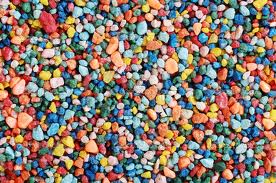The importance of the right substrate is often overlooked when setting up an aquarium. There are many different types and sizes available but which should you go for? Here are a few of the options available and things to consider when deciding upon this.
The colour of the substrate is quite a key element both to how the aquarium looks and how your fish will react to it. Tropical fish are very conscious of their environment and as such will react accordingly when their environment isn’t how they would expect or be comfortable in. For rift valley cichlids as an example, they will generally colour up more and therefore be more aesthetically pleasing if they have a natural lighter coloured substrate and gravel. I don’t believe any fish would like to be in a tank with multi-coloured fluorescent gravel so this is quite unfair on the fish I my opinion.

Size of the gravel used is extremely key to maintaining a healthy living environment for your fish in the long term. If the gravel you use is too fine then it will end up clumping up and forming a layer which harmful chemicals cannot penetrate. Waste and therefore harmful nitrates and nitrites, not to mention ammonia will build up under the gravel if it is too fine leading to very unhealthy environment for your fish. You will know if this is the case when you run your fingers though the gravel and bubbles come up from it. It is therefore recommended that if you must use plays and or another fine gravel then you thoroughly agitate it on a weekly basis to ensure chemical build up is kept to a minimum. From experience I would avoid this though and spend a little more on something which isn’t play sand as this will save you time and money in the future should the play sand cause you problems.
There are a huge range of substrate types available in the market today including fertiliser for planted tanks, standard aquarium gravel in many sizes and colours and even eco complete type of cichlid sand which is ready washed and chemically balanced so it can be poured straight in to the tank.
This brings me on to my next point, except for the eco complete gravel types, it is always recommended that you thoroughly wash any sort of sand or gravel before putting it in to the aquarium. The best method I have found of doing this is to half fill a bucket with the sand and run the shower on it whilst running your fingers through it. This way you don’t get sand down the plug hole and any impurities or harmful chemicals can be washed off before it enters your tanks eco system.
It is possible to use multiple types of substrate in your fish tank aquarium however it is worth bearing in mind that some fish, primarily cichlids, will dig in the substrate thereby mixing up the layers or areas of gravel you have laid out.
Although, often overlooked, when you consider the gravel is something which takes up the whole area of your aquarium, it can have a massive impact on the overall look of the tank so some serious consideration and thought should be taken when deciding on which substrate you are going to use.
JBL Sansibar RIVER 10 kg, Light, fine substrate with black pebbles for freshwater and marine aquariums
Features:- Substrate with 0.8 mm grain size for freshwater and marine aquariums and terrariums
- Prevents injuries of the mucous membrane: coarse-grained, round-shaped natural sand is gentle on sensitive barbels. Ideal for digging fish, such as rays, kuhli loarch, catfish, etc.
- Ideal for fish, invertebrates and plants: no unwanted pollutants released into the water.
- Use: Spread substrate on top of the nutrient substrate (approx. 6-8 cm for vigorous plant growth). Well suited for undergravel heater cables
- Contents: 1 bag Sansibar River
JBL Manado 10 l, Natural substrate for freshwater aquariums
Features:- Optimal plant care through porous structure and nutrient storage function: substrate for freshwater aquariums
- Vigorous plant growth, prevents algae: effective settlement of beneficial soil bacteria and ideal root growth thanks to natural pore structure. Support for the filter. Crystal-clear water
- Ideal for fish, invertebrates and plants: no unwanted pollutants released into the water. Round-shaped granule grains are gentle on sensitive barbels of bottom-dwellers
- High storage capacity: the natural substrate absorbs the surplus nutrients and releases them when required
- Contents: substrate Manado. Available in various sizes
JBL ProScape PlantSoil BROWN 3 l, Brown freshwater substrate for aquascaping
Features:- Complete nutrient substrate for aquatic plants: special substrate for aquascaping aquariums
- Vital plant growth: optimal oxygen supply and circulation due to medium grain size
- Immediate nutrient and mineral supply for plants
- Tropical water values: slightly acidic pH values and low carbonate hardness. Reduces water hardness – water becomes soft
- Contents: 1 bag ProScape PlantSoil Brown
JBL AquaBasis plus 5 l, Long-lasting nutrient substrate for freshwater aquariums
Features:- Nutrient substrate for beautiful and permanent plant growth in all freshwater aquariums. Works for 5 years guaranteed
- Nutrient store: contains important plant nutrients, such as iron. Clay components store nutrients and release them again, as required.
- Efficiently prevents unwanted algae growth by promoting plant growth
- How to use for the initial setup: add the nutrient substrate and cover with a layer of rinsed substrate
- Contents: 1 pack of ready to use, long-lasting nutrient substrate






Related Posts
A Deeper Look In To Loach Fish Species
How Much Salt Should I Add To My Freshwater Aquarium
Everything You Need To Know About Using T5 Lights For Your Aquarium